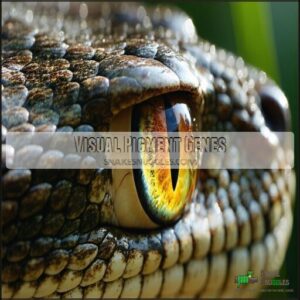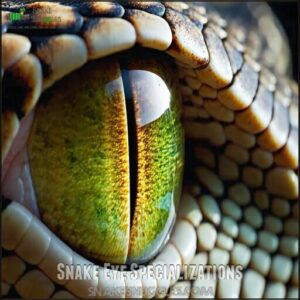This site is supported by our readers. We may earn a commission, at no cost to you, if you purchase through links.

Most snakes have dichromatic vision, which means they can detect ultraviolet light and see blues and yellows, but not reds.
This unique vision helps them navigate and hunt.
You’ll find that their color perception is limited compared to humans, but it’s adapted to their environment.
As you explore the realm of snake vision, you’ll discover more about their visual abilities and how they use them to survive, and that’s just the beginning of uncovering the secrets of their remarkable senses.
Table Of Contents
- Key Takeaways
- Snake Vision Basics
- Can Snakes See Color
- Dichromatic Vision Explained
- Snake Eye Specializations
- Color Vision in Snake Species
- Frequently Asked Questions (FAQs)
- What colors can snakes not see?
- What does a snakes vision look like?
- What colors attract snakes?
- How do snakes see humans?
- Can pet snakes recognize their owners by sight?
- How far can a snake see clearly?
- Do all snake species see the same colors?
- Can snakes see better underwater?
- Do snakes dream in color?
- Can snakes distinguish objects in low light?
- Conclusion
Key Takeaways
- You’ll find that snakes can see in color, but not like you do – they have dichromatic vision, which means they can detect ultraviolet light and see blues and yellows, but not reds.
- Snakes’ unique vision helps them navigate and hunt, and it’s adapted to their environment, so it’s not a disadvantage, but rather a specialized way of seeing the world.
- You’ll discover that snakes’ color perception is limited compared to humans, and they rely more on movement detection and heat sensing than visual acuity, which is why they can’t see objects clearly at a distance.
- As you learn more about snake vision, you’ll find that different species have varying levels of color vision, with some, like sea snakes, having more advanced color vision due to genetic adaptations, which is a key aspect of their ability to thrive in diverse environments.
Snake Vision Basics
Regarding snake vision, it’s more complex than you might think. Their eyes have evolved over millions of years, adapting to different environments and lifestyles with remarkable precision.
Snake vision is more complex than you think, evolving over millions of years with remarkable precision.
Evolution of Snake Vision
You explore the evolution of snake vision, discovering ancestral snake vision adapted to low-light conditions.
Visual gene changes led to environmental adaptations, resulting in dichromatic origins, shaping snake vision and color perception through sensory evolution, influenced by visual pigment genes and snake evolution.
Structure of Snake Eyes
You’re looking at the structure of snake eyes, which includes:
- Retinal Cell Types
- Lens UV Blocking
- Eye Mobility
- Infrared Receptors, featuring retinal pigments, rods, and cones, making snake vision unique.
Visual Pigment Genes
You’ll discover that visual pigment genes, like opsin SWS1, play a vital role in snakes’ color vision, with gene duplication affecting wavelength sensitivity and retinal pigments, leading to evolutionary changes in dichromatic vision.
Notably, sea snakes regained color vision, showcasing their remarkable adaptability to diverse environments, which is a key aspect of their ability to thrive in various settings with diverse environments.
Can Snakes See Color
You’re wondering if snakes can see in color.
Snakes see the world differently, with limited color vision and unique adaptations.
Research shows that most snakes have dichromatic vision, with limitations in color perception.
Here are some key points:
- Snakes have UV sensitivity
- Dichromatic limitations affect color vision
- Sea snake vision is an exception
- Pigment variations occur in cones
Snakes aren’t entirely colorblind, but their color vision is different from humans.
They’ve cones sensitive to UV light and other wavelengths, allowing for unique color perception.
Some species, like sea snakes, have even regained color vision, showcasing remarkable adaptation.
This ability to see in UV light is crucial for their survival.
Dichromatic Vision Explained
You’re about to discover how snakes see the world, and it’s not exactly like human vision.
As you learn about dichromatic vision, you’ll find that snakes can see two primary colors, but their color perception is limited compared to humans, which is related to their limited color vision.
UV Vision in Snakes
You’ll find most snakes have UV vision, aiding in low-light conditions.
With nocturnal species using it for hunting and diurnal species having UV-blocking lenses for clear vision.
Showcasing evolutionary advantages of UV light detection in their unique visual system.
Limited Color Perception
You’ve seen how snakes use UV light, but how does that affect their color perception in animals? Snakes aren’t exactly painting rainbows. Their world is more limited. It’s like having mild colorblindness.
This dichromatic vision—seeing mostly two primary colors—is an environmental adaptation, not a disadvantage.
Here’s what you might experience:
- Fewer colors.
- Difficulty distinguishing reds.
- Reliance on shades.
- Enhanced contrast.
Wavelength sensitivity is key! This aspect of their vision highlights the unique way snakes perceive their surroundings, which is crucial for their survival.
Comparison to Human Vision
You compare snake vision to human vision, noting humans see more primary colors.
Snakes’ eyes, protected by transparent scales, lack eyelids.
| Color Perception | Visual Acuity | Light Sensitivity |
|---|---|---|
| Dichromatic | Limited | High |
| Trichromatic | High | Medium |
| Dichromatic | Medium | Low |
| Trichromatic | Low | High |
Snake Eye Specializations
You’re about to explore the unique features of snake eyes, which have adapted to their environment in remarkable ways.
As you learn about snake eye specializations, you’ll discover how their eyes are equipped with rods and cones that enable them to detect movement and see in low light conditions.
Rods and Cones in Snake Eyes
You’re exploring snake eyes, specifically rods and cones.
Snakes have diverse rod and cone types, with rod sensitivity aiding nocturnal adaptations, while cone cells enable color vision, utilizing various visual pigments in their retina function.
Infrared Detection in Snakes
You discover snakes use pit organs, located between their eyes and nostrils, for infrared detection, aiding in heat sensing and thermal detection.
Some snakes, especially pit vipers, have enhanced infrared hunting capabilities with precise heat sensing range and sensory integration.
Some may even use an infrared snake detector to study this infrared detection ability.
Visual Acuity in Different Species
You’ll find visual acuity varies among snake species, influenced by Diurnal vs. Nocturnal lifestyles, Aquatic vs. Terrestrial habitats, and Hunting Style Impact.
With evolutionary pressures shaping their unique snake vision and eyesight, affecting color vision in snakes.
Color Vision in Snake Species
You’re about to explore the fascinating world of snake color vision, where you’ll discover that most snakes are dichromatic, seeing two primary colors.
As you learn more about color vision in snake species, you’ll find that their ability to see in color varies, with some species, like sea snakes, exhibiting unique adaptations that set them apart from other snakes.
Variations in Color Vision
You’ll notice variations in color vision among snakes due to genetic mutations and environmental adaptation, resulting in dichromatic variations.
Species comparison reveals differences in wavelength sensitivity, with cones and photoreceptor cells playing a key role in color vision range, affecting how snakes perceive their surroundings, which can be influenced by genetic mutations.
Examples of Color Vision in Sea Snakes
You examine sea snakes’ color vision, noting genetic adaptations like opsin SWS1 gene duplications, which enable aquatic vision.
Some species:
- Regain color vision
- Exhibit wavelength sensitivity
- Possess enhanced color vision
through these adaptations, sea snakes’ color vision is unique.
Research on Snake Color Vision
You explore research on snake color vision, delving into color vision genes, pigment evolution, and species variations, revealing dichromatic snakes’ UV sensitivity and unique eyesight.
Shedding light on snake vision research and the fascinating world of color vision in snakes, some species exhibit limited color perception due to their evolutionary history.
Frequently Asked Questions (FAQs)
What colors can snakes not see?
You’ll discover snakes are dichromatic, seeing blues and greens, but they can’t see reds, as their visual pigments aren’t sensitive to longer wavelengths, limiting their color vision capabilities substantially.
What does a snakes vision look like?
Sophisticated serpent sight shows you a somewhat blurry, dichromatic view, with sensitivity to movement and UV light, but limited visual acuity, making it unique and adapted to their environment.
What colors attract snakes?
You’ll attract snakes with warm, dark colors, and textures, as they’re drawn to heat, shelter, and ambush points, often associating these with food or hiding spots.
How do snakes see humans?
You see humans as blurry, moving shapes, detecting heat and movement rather than detailed colors or features, thanks to their limited eyesight and specialized heat-sensing organs.
Can pet snakes recognize their owners by sight?
You’re a puzzle piece, and recognizing owners is tricky; pet snakes likely use chemosensation and movement, not sight, to identify you, their trusted handler, in a complex dance of senses.
How far can a snake see clearly?
You’ll find snakes have relatively poor eyesight, with clear vision limited to a few feet, relying more on movement detection and heat sensing than visual acuity for navigation and hunting.
Do all snake species see the same colors?
A million questions swirl in your mind – you’ll discover most snakes are dichromatic, seeing two primary colors, but not all species see the same colors, surprisingly.
Can snakes see better underwater?
You’ll discover most snakes have poor underwater vision, as their eyes aren’t adapted for aquatic environments, relying more on sensory cues than visual acuity.
Do snakes dream in color?
You’ll be surprised that 99% of snakes have poor eyesight, so it’s unlikely they dream in color, given their limited visual capabilities and brain structure.
Can snakes distinguish objects in low light?
You can distinguish objects in low light, as snakes have adapted to see in dim conditions, using UV sensitivity and rod cells to detect movement and light.
Conclusion
You’ve learned that 70% of snakes have dichromatic vision.
Now, you know can snakes see in color, but differently than you.
They detect ultraviolet light and see blues and yellows, aiding navigation and hunting.
Understanding can snakes see in color reveals their unique visual abilities, adapted to their environment, and helps you appreciate their remarkable senses.
- https://www.nhm.ac.uk/discover/news/2016/september/study-sheds-light-on-snake-vision.html
- https://en.wikipedia.org/wiki/Elapidae
- https://academic.oup.com/gbe/article/15/7/evad107/7219516
- https://www.adelaide.edu.au/front/international.html?adobe_mc_sdid=SDID%3D7AFBFBD1A1900C7D-023AA5090D2B288C%7CMCORGID%3DBA023B045D5A83160A495E49%40AdobeOrg%7CTS%3D1689269319












